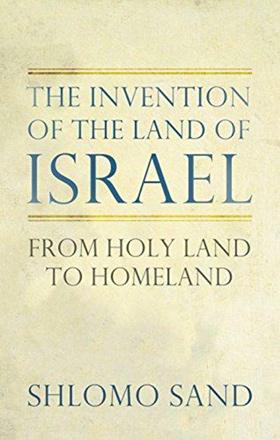You are here
Is the Bible a title deed to Palestine?
By Sally Bland - Feb 17,2019 - Last updated at Feb 17,2019

The Invention of the Land of Israel: From Holy Land to Homeland
Shlomo Sand
London: Verso, 2014
Pp. 295
Shlomo Sand, a history professor at Tel Aviv University, became famous after publishing “The Invention of the Jewish People” (2008), in which he deconstructed the historical myths about Jews as being a racial group and a wandering people in exile, and for which he was attacked by many Zionist critics. In the introduction to this new book, he writes, “I never expected that, at the beginning of the 21st century, so many critics would step forward to justify Zionist colonisation and the establishment of the State of Israel by invoking claims of ancestral lands, historical rights and millennia-old national yearnings.” (p. 10)
He had thought that most justifications would refer to the persecution of Jews in Europe in the late 19th and early 20th centuries, but he had underestimated the strength of the rabid nationalism which Zionism has injected into mainstream Jewish thinking.
With “The Invention of the Land of Israel”, Sand aims to deconstruct “the concept of the Jewish ‘historical right’ to the Land of Israel and its associated nationalist narratives, whose only purpose was to establish moral legitimacy for the appropriation of territory”. (p. 29)
To this end, he surveys the Bible as well as other Jewish holy books, and religious and philosophical texts from ancient until modern times, to show that up until the 18th century, “In no text or archaeological finding do we find the term ‘Land of Israel’ used to refer to a defined geographical region.” (p. 25)
Instead, other terms prevailed, such as the land (unspecified), the Land of Canaan or Palestine.
Perhaps the most important theme of this book is Sand’s strict demarcation between Judaism and Zionism; an entire chapter is entitled “Zionism vs Judaism”. According to Sand, traditionally in Judaism, “The need for a holy place in which perfect cosmic order existed never equated to a human desire to actually live in it or to be always in close proximity to it.” (p. 108)
Moreover, there were several religious injunctions against settling in the Holy Land, and pilgrimage was not particularly commonplace.
Sand analyses how the advent of nationalism and, concurrently, anti-Semitism in 19th century Europe changed all that, motivating the establishment of the Zionist movement, its conscious dovetailing with colonial plans and its interconnection with Christian Zionism. As a result, Jewish history was reinterpreted and rewritten in retrospect, with a strong nationalist and racial/ethnic slant. “It was during this period that we see the beginning of efficient and consistent production of a new kind of collective identity that reshaped the Jewish past, making it more territorial.” (p. 208)
“At the end of the day, the Zionist revolution succeeded in nationalising the main elements of Zionist religious discourse... during the 20th century, the Holy Land became the ‘Land of Israel’,“ as Israel was established by force of arms and grew with the new territorial conquests in 1967. (p. 196)
The book is carefully written and documented. Sand’s review of Jewish writing and thinking over centuries is broader and more detailed than the usual accounts of the birth of Zionism and Israel. Especially interesting is his account of the initially strong opposition to Zionism among major Jewish communities. His view of history is international and sweeping, giving a nuanced picture of cause-and-effect, as events in the Middle East are counterposed to those in Europe. His outlook is universalist, humanistic and oriented towards social justice, in contrast to the early debates about the merits of Zionism, which were conducted in an exclusively Jewish framework. “In all the debates... the presence of Arabs in Palestine was almost never raised.” (pp. 197-8)
Sand writes about the nakba but doubts that such a major displacement of Palestinians would have occurred if not for the war initiated by the Arab regimes. This doubt is not well-founded, since one half of the Palestinians who were dispossessed in 1947-8 were driven from their homes prior to the Arab armies’ entry into Palestine, i.e., the process was already well underway. The rest of the book is a generally accurate rendition of Israel’s settlement-building and Judaisation campaigns post-1948, but not as ground-breaking as the first part of the book.
Other authors whose analysis is as incisive as Sand’s have despaired of the two-state solution by now, finding it surpassed by the reality of Israel’s settlement-building and fragmentation of Palestine. Sands also sees it as a “fading dream”, but as he does not envision a major Palestinian return, he cannot offer a better model for peace. Rather, he emphasises memory and the need for Israelis to acknowledge the pain they have caused Palestinians. Sand makes his own contribution to this in the afterword of the book, which is devoted to Sheikh Muwannis, the largest Palestinian village north of Jaffa, on whose ruins the author’s place of work and residence sprang up after the villagers were terrorised out of their homes by the combined efforts of the Haganah and Stern Gang in the spring of 1948.
“The Invention of the Land of Israel” is available at the University Bookshop’s website.
Related Articles
Cracks in the Wall: Beyond Apartheid in Palestine/IsraelBen WhiteLondon: Pluto Press, 2018Pp.
Decolonising Israel, Liberating Palestine: Zionism, Settler Colonialism, and the Case for One Democratic StateJeff HalperLondon: Pluto Press
On PalestineNoam Chomsky and Ilan PappeEdited by Frank BaratUS: Haymarket Books, UK: Penguin, 2015Pp.



















